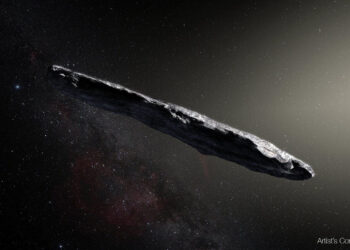
On July 1, 2025, a telescope in Chile detected something unexpected: a faint object streaking across the sky at an unusual speed and angle. Within hours, astronomers realized what they were seeing. This wasn’t a comet from the outer reaches of our own solar system, but rather a cosmic drifter from another star.
The object, now officially named 3I/ATLAS, is only the third confirmed interstellar visitor ever observed in our solar system. It’ll pass through our system and then continue its journey, likely never to return again.
This is what makes it all the more interesting.
What is 3I/ATLAS?
3I/ATLAS, also known as C/2025 N1, is a comet from interstellar space, meaning it originated in another star system and entered our solar system on a one-time flyby. It was first spotted by the ATLAS survey telescope in Río Hurtado, Chile (a NASA-funded program designed to scan the sky for potentially dangerous asteroids).
The “3I” in its name stands for “third interstellar,” following in the footsteps of 1I/ʻOumuamua (2017) and 2I/Borisov (2019), the previous two interstellar objects that passed through our solar system while we were looking.
The object is moving fast (about 58 kilometers per second) and its path is a sharp, hyperbolic curve, indicating it isn’t bound significantly by the Sun’s gravity. It’s also the most extreme orbit ever observed for a natural object in the solar system.
ATLAS captured the first official sighting on July 1, 2025, but when researchers looked at earlier data, they found it in images dating back to June 14. Initially, the object didn’t appear to show signs of cometary activity. Astronomers reported no clear tail or outgassing. But within a day, multiple observatories did detect a faint coma and a short tail. That meant it was not just a rocky asteroid — it was a true interstellar comet, more like Borisov than ‘Oumuamua.
Is it dangerous for us?
Not in the slightest.
Its closest approach to the Sun (the perihelion) is set to be around October 29–30, 2025. The object will pass about 1.35 AU from us, with 1 AU being equal to the distance between the Earth and the Sun. In other words, the comet will pass just inside the orbit of Mars, but not much closer to our planet.
The closest approach to Earth is expected to be in December 19, at about 0.36 AU. If that sounds concerning, it’s still about 270 million kilometers (or 170 million miles).
It will be observable with powerful telescopes through September 2025. Then it will pass behind the Sun, reappearing in December for a second observational window.
What is this object made of, what does it look like?
Every interstellar object gives us a rare sample of material from another solar system. We can’t yet send spacecraft to other stars, but sometimes, their building blocks come to us. This is why astronomers are keen to get as much information about this object as possible.
Initial estimates of the comet’s size ranged widely, from a few kilometers up to 20 kilometers across. But here’s where it gets complicated.
While the object appears bright, much of that brightness might not be from the solid core. Instead, it could be caused by sunlight reflecting off a surrounding cloud of dust and gas — what astronomers call the coma.
So far, 3I/ATLAS appears to have a reddish hue, much like 2I/Borisov. This would suggest a dusty, icy composition, a mix of volatile materials that vaporize when warmed by the Sun. Spectral analysis is ongoing. But so far, the object shares characteristics with both of its predecessors. ʻOumuamua lacked any visible activity, while Borisov was clearly an active comet. ATLAS appears to sit in the middle: active, but modestly so.
For now, researchers hope to observe 3I/ATLAS using the capability from existing cutting-edge telescopes. In particular, the new Vera C Rubin could track its path and brightness across the sky, and even the JWST could turn its glance towards the object, to probe its chemical makeup in infrared.
It’s an exciting visit that scientists are looking to make the most of.






